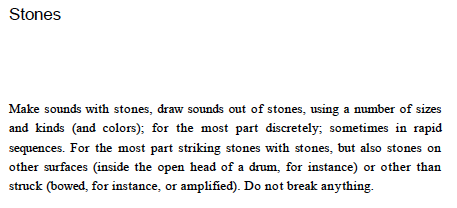When you see the word music you probably think of being in the audience or on stage at a concert, or listening to a recording of someone playing. However, music doesn’t have to be thought about in this way. In the last 20 years or so, composers have started writing pieces to be performed by one person at home on their own, which just happens to be perfect for our current situation!
Here are a few pieces that demonstrate a different way of 'playing' that you could try performing at home:
Go hunting for either sticks or stones, and then make sounds with them! There are a few rules: don’t break or set fire to anything, but otherwise let your imagination run wild!

Stompy by Hugh Morris
Collect lots of aluminium cans, then put them all together, get your best stomping boots on and squish the lot of them! Listen to all the different types of sound you can get from them. Your grown-ups will be glad to help empty the cans beforehand!
evolution occurs very slowly or not at all by James Saunders
Find a noise somewhere around the house, and then try to recreate it as closely as you can using your instrument and other materials you can find. If you can, record your recreation and see how close it is. Click the link above to see the original piece for more inspirational ideas.
Listening Pieces
A smaller subset of these pieces are what I would call listening pieces. The most famous and possibly earliest of these is 4:33 by John Cage, first performed in 1952. The score for this piece has no notes, instead, the performer sits silently for 4 minutes and 33 seconds (split into three movements like a suite or a symphony). Here is a performance by David Tudor.
The idea of lots of people sitting listening to nothing probably sounds quite silly, but there is another interesting level to the piece. The first performance of 4:33 took place in a concert hall, in the countryside, during the summer. This concert hall would leave the doors open for people to sit and listen from the benches outside. During the performance, people found that they could hear all sorts of unintentional sounds, from birds, to the wind, to the rain.
John Cage himself said:
Here are a few other listening pieces and activities for you to try at home:
How many sounds you can hear and write down in a minute? Ten minutes? An hour? See who in your household can list the most sounds in that time.
Describe a sound you’ve heard before. See if someone else can guess the sound. For example; “A low, quiet humming sound, then a click and the silence.” - It’s the fridge! “A high pitched sound, lots of different notes quickly.” - A bird! (A blackbird specifically).
stand in an open doorway/face the frame/listen to both sides simultaneously by Oliver Ginger As the title says, stand in the doorway facing the door frame and try to listen to the differences between the two rooms. What can you hear in one ear that you cant in the other?
Scanning – Hearing by Pauline Oliveros

Field Recordings
Another type of piece that can be made and listened to at home are field recordings. A field recording is when you record the sounds that are going on around you; they are like an audio photograph of a place.
Why not take a trip around the world in sound, using this website. It has field recordings from almost everywhere. I’ve just listened to the sound of the sea in Samoa, a village in Iceland and a jungle in the Philippines!
If you want to explore one place in detail, try listening to Jez riley French's albums of field recordings. Resonances - Leigh woods might show you some new sounds in Leigh Woods, right here in Bristol. Or if you prefer indoors, try audible silence, Tate Modern (sleeping and waking)
Maybe you could try your hand at field recording? Have a go and then listen to what you've made. Did you notice any sounds you hadn't noticed before? For some ideas, here is a recording of my garden in Bristol.
Written by Joe Hamlen




Comments